Ordering Nuclear War: Gen. Selva Tells Us What Happens
Posted on

VCJCS Gen. Selva
CAPITOL HILL: The security of nuclear command and control is the Holy Grail of the US military. Nothing, especially in these turbulent days, matters more. Aside from occasional talk about the nuclear football — as the case containing the nuclear codes is known — most Americans know little about what would happen in the event that the president needed to order a nuclear strike.
In a moment of utter lucidity on the topic, Vice Chairman of the Joint Chiefs of Staff Gen. Paul Selva outlined this morning just what the standards and broad actions are governing the most grim order anyone would ever have to make. He spoke at a breakfast on nuclear issues sponsored by the Air Force Association’s Mitchell Institute.
I asked Selva if there were lessons to be learned for the next iteration of the nuclear command and control system from the Air Force’s early work on the Multi-Domain Command and Control system (MDC2), designed to take data from as many sources around the world as possible and allow commanders to use that data to good effect no matter whether it’s from a ship, a submarine, a plane, a soldier, sailor, airman, Marine or a satellite.
I spoke after his remarks with a very experienced nuclear warfare expert who said Selva’s description was the clearest and most concise he had ever heard about nuclear command and control.

Air Force missileers.
We’ll let Selva be Selva:
“The nuclear command and control system: if it’s not a stand-alone system then it becomes subject to all of the vulnerabilities of any other command and control system you hook it up to.
“The fact of the necessity to identify and validate the person and the order means the nuclear command system must and should be separate and distinct from all the other services that we provide across our networks to national leaders who have other tasks.
“The way I’ve explained it to the Defense Science Board — they disagree with me, and I’ll say that publicly — nuclear command and control is a low context proposition. You need to ask and answer about five or six questions to get the intent of the commander in chief. Once you have the intent of the commander in chief you offer him options, or her options. He or she selects an option and when that’s done you must validate who they are.
“That’s the simplicity of the process. Don’t get me wrong. It’s incredibly complicated. But any other decision they are going to make I would argue is a high context decision.
“You can debate, discuss, have policy meetings, determine the course of action you want to go on and enter on that course of action and change it later because you have the benefit of time. But in the worst set of circumstances, which is what the nuclear command and control system is built upon, time is of the essence. Clarity is absolutely required. and the ability to identify the person selecting the option and giving the order is an absolute. So you have to build those in.”
Subscribe to our newsletter
Promotions, new products and sales. Directly to your inbox.
